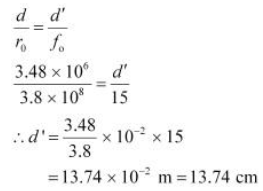Focal length of the objective lens, fo = 15 m = 15 × 102 cm
Focal length of the eyepiece, fe = 1.0 cm
(a) The angular magnification of a telescope is given as:

Hence, the angular magnification of the given refracting telescope is 1500.
(b) Diameter of the moon, d = 3.48 × 106 m
Radius of the lunar orbit, r0 = 3.8 × 108 m
Let d' be the diameter of the image of the moon formed by the objective lens. The angle subtended by the diameter of the moon is equal to the angle subtended by the image.

Hence, the diameter of the moon’s image formed by the objective lens is 13.74 cm